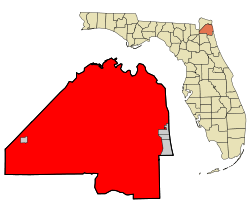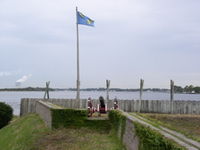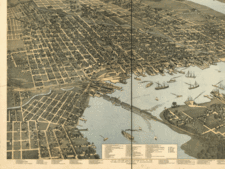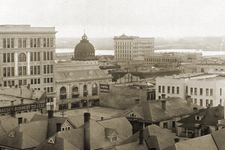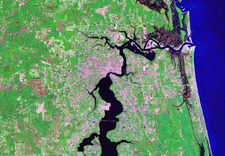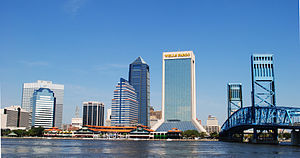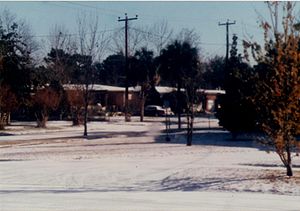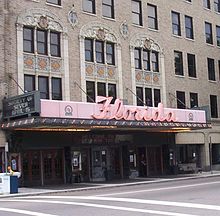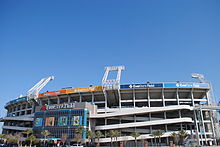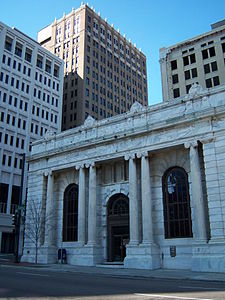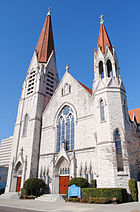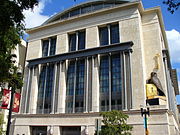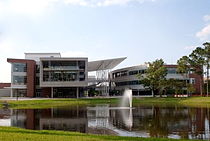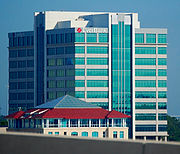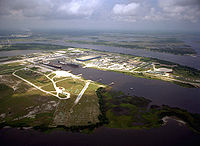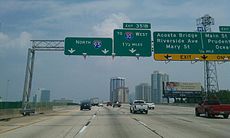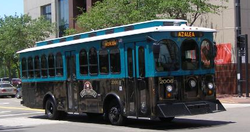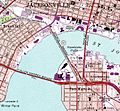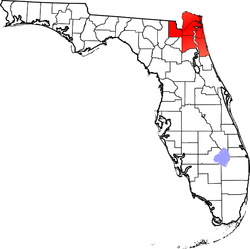- Jacksonville, Florida
-
"Jacksonville" redirects here. For other uses, see Jacksonville (disambiguation).
City of Jacksonville, Florida — Consolidated city–county — Top, left to right: Downtown Jacksonville, Riverplace Tower, statue of Andrew Jackson, Florida Theatre, Dames Point Bridge, Veterans Memorial Arena, EverBank Field, Friendship Fountain, Jacksonville Landing 
Flag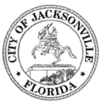
SealNickname(s): Jax, The River City, J-ville, The Bold New City Of The South Motto: Where Florida Begins Location in Duval County and the state of Florida Location in the United States Coordinates: 30°19′10″N 81°39′36″W / 30.31944°N 81.66°W Country United States State Florida County Duval Founded 1791 Incorporated 1832 Government - Type Strong Mayor-Council - Mayor Alvin Brown (D) - Governing body Jacksonville City Council Area - Consolidated city–county 885 sq mi (2,292.15 km2) - Land 767 sq mi (1,986.53 km2) - Water 116.6 sq mi (302.1 km2) Elevation 16 ft (5 m) Population (2010)[1] - Consolidated city–county 821,784 (11th) - Density 1,061.6/sq mi (409.89/km2) - Urban 913,125 - Metro 1,525,228 Time zone EST (UTC-5) - Summer (DST) EDT (UTC-4) ZIP code 32099, 32201-32212, 32214-32241, 32244-32247, 32250, 32254-32260, 32266, 32267, 32277, 32290. Area code(s) 904 FIPS code 12-35000[2] GNIS feature ID 0295003[3] Website http://www.coj.net/ 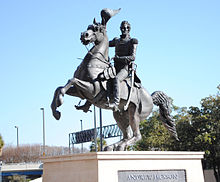 Downtown statue of Andrew Jackson
Downtown statue of Andrew Jackson
Jacksonville is the largest city in the U.S. state of Florida in terms of both population and land area, and the largest city by area in the contiguous United States.[4] It is the county seat of Duval County,[5] with which the city government consolidated in 1968. The consolidation gave Jacksonville its great size and placed most of its metropolitan population within the city limits; with a population of 821,784, it is the most populous city proper in Florida[6] and the eleventh most populous in the United States. Jacksonville is the principal city in the Greater Jacksonville Metropolitan Area, with a population of 1,313,228.[7]
Jacksonville is in the First Coast region of northeast Florida and is centered on the banks of the St. Johns River, about 25 miles (40 km) south of the Georgia border and about 340 miles (547 km) north of Miami. The Jacksonville Beaches communities are along the adjacent Atlantic coast. The area was originally inhabited by the Timucua people, and in 1564 was the site of the French colony of Fort Caroline, one of the earliest European settlements in what is now the continental United States. Under British rule, settlement grew at the narrow point in the river where cattle crossed, known as Wacca Pilatka to the Seminole and the Cowford to the British. A platted town was established there in 1822, a year after the United States acquired the colony of Florida from Spain; it was named after Andrew Jackson, the first military governor of the Florida Territory and seventh President of the United States.
Harbor improvements since the late 19th century have made Jacksonville a major military and civilian deep-water port. Its riverine location facilitates two U.S. Navy bases and the Port of Jacksonville, Florida's third largest seaport.[8] Significant factors in the local economy include services such as banking, insurance, and healthcare. As with much of Florida, tourism is also important to the Jacksonville area, particularly tourism related to golf.[9][10]
Contents
History
Main article: History of Jacksonville, FloridaThe area of the modern city of Jacksonville has been inhabited for thousands of years. On Black Hammock Island in the national Timucuan Ecological and Historic Preserve, a University of North Florida team discovered some of the oldest remnants of pottery in the United States, dating to 2500 BC.[11] In the 16th century, the beginning of the historical era, the region was inhabited by the Mocama, a coastal subgroup of the Timucua people. At the time of contact with Europeans, all Mocama villages in present-day Jacksonville were part of the powerful chiefdom known as the Saturiwa, centered around the mouth of the St. Johns River.[12] One early map shows a village called Ossachite at the site of what is now downtown Jacksonville; this may be the earliest recorded name for that area.[13]
European explorers first arrived in the area 1562, when French Huguenot explorer Jean Ribault charted the St. Johns River. In 1564, René Goulaine de Laudonnière established the first European settlement, Fort Caroline, on the St. Johns near the main village of the Saturiwa. On September 20, 1565, a Spanish force from the nearby Spanish settlement of St. Augustine attacked Fort Caroline, and killed nearly all the French soldiers defending it.[14] The Spanish renamed the fort San Mateo, and following the ejection of the French, St. Augustine's position as the most important settlement in Florida was solidified.
Spain ceded Florida to the British in 1763, after the French and Indian War, and the British soon constructed the King's Road connecting St. Augustine to Georgia. The road crossed the St. Johns River at a narrow point, which the Seminole called Wacca Pilatka and the British named the "Cow Ford", both names ostensibly reflecting the fact that cattle were brought across the river there.[15][16][17] Britain ceded control of the territory back to Spain in 1783, after its defeat in the American Revolutionary War, and The settlement at the Cow Ford continued to grow. After Spain ceded the Florida Territory to the United States in 1821, American settlers on the north side of the Cow Ford decided to plan a town, laying out the streets and plats. They soon named the town "Jacksonville", after Andrew Jackson. Led by Isaiah D. Hart, residents wrote a charter for a town government, which was approved by the Florida Legislative Council on February 9, 1832.
During the American Civil War, Jacksonville was a key supply point for hogs and cattle being shipped from Florida to aid the Confederate cause. The city was blockaded by Union forces, who gained control of the nearby Fort Clinch. From 1862, they controlled the city and most of the First Coast for the duration of the war. Though no battles were fought in Jacksonville proper, the city changed hands several times between Union and Confederate forces. Warfare and the long occupation left the city disrupted after the war.
During Reconstruction and the Gilded Age, Jacksonville and nearby St. Augustine became popular winter resorts for the rich and famous. Visitors arrived by steamboat and later by railroad. President Grover Cleveland attended the Sub-Tropical Exposition in the city on February 22, 1888 during his trip to Florida.[18] This highlighted the visibility of the state as a worthy place for tourism. The city's tourism, however, was dealt major blows in the late 19th century by yellow fever outbreaks. In addition, extension of the Florida East Coast Railway further south drew visitors to other areas. From 1893 to 1938 Jacksonville was the site of the Florida Old Confederate Soldiers and Sailors Home with a nearby cemetery.[19]
On May 3, 1901, downtown Jacksonville was ravaged by a fire that started at a fiber factory. Known as the "Great Fire of 1901", it was one of the worst disasters in Florida history and the largest urban fire in the southeastern United States. In just eight hours, it destroyed the business district and left approximately 10,000 residents homeless. It is said the glow from the flames could be seen in Savannah, Georgia, and the smoke plumes in Raleigh, North Carolina. Architect Henry John Klutho was a primary figure in the reconstruction of the city. More than 13,000 buildings were constructed between 1901 and 1912.
In the 1910s, New York–based filmmakers were attracted to Jacksonville's warm climate, exotic locations, excellent rail access, and cheap labor. Over the course of the decade, more than 30 silent film studios were established, earning Jacksonville the title of "Winter Film Capital of the World". However, the city's conservative political climate and the emergence of Hollywood as a major film production center ended the city's film industry. One converted movie studio site, Norman Studios, remains in Arlington; It has been converted to the Jacksonville Silent Film Museum at Norman Studios.[20]
 Motion picture scene at Gaumont Studios, 1910
Motion picture scene at Gaumont Studios, 1910
During this time, Jacksonville also became a banking and insurance center, with companies such as Barnett Bank, Atlantic National Bank, Florida National Bank, Prudential, Gulf Life, Afro-American Insurance, Independent Life and American Heritage Life thriving in the business district. The U.S. Navy also became a major employer and economic force during the 1940s, with the construction of three naval bases in the city.
Jacksonville, like most large cities in the United States, suffered from negative effects of rapid urban sprawl after World War II. The construction of highways led residents to move to newer housing in the suburbs. After World War II, the government of the city of Jacksonville began to increase spending to fund new public building projects in the boom that occurred after the war. Mayor W. Haydon Burns' Jacksonville Story resulted in the construction of a new city hall, civic auditorium, public library and other projects that created a dynamic sense of civic pride. However, the development of suburbs and a subsequent wave of middle class "white flight" left Jacksonville with a much poorer population than before.
Much of the city's tax base dissipated, leading to problems with funding education, sanitation, and traffic control within the city limits. In addition, residents in unincorporated suburbs had difficulty obtaining municipal services, such as sewage and building code enforcement. In 1958, a study recommended that the city of Jacksonville begin annexing outlying communities in order to create the needed tax base to improve services throughout the county. Voters outside the city limits rejected annexation plans in six referendums between 1960 and 1965.
In the mid 1960s, corruption scandals began to arise among many of the city's officials, who were mainly elected through the traditional good ol' boy network. After a grand jury was convened to investigate, 11 officials were indicted and more were forced to resign. Consolidation, led by J. J. Daniel and Claude Yates, began to win more support during this period, from both inner city blacks, who wanted more involvement in government, and whites in the suburbs, who wanted more services and more control over the central city. In 1964 all 15 of Duval County's public high schools lost their accreditation. This added momentum to proposals for government reform. Lower taxes, increased economic development, unification of the community, better public spending and effective administration by a more central authority were all cited as reasons for a new consolidated government.
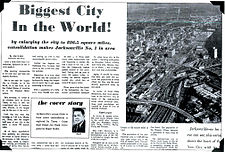 News of Jacksonville's consolidation from The Florida Times-Union.
News of Jacksonville's consolidation from The Florida Times-Union. For more details on this topic, see Jacksonville Consolidation.
For more details on this topic, see Jacksonville Consolidation.When a consolidation referendum was held in 1967, voters approved the plan. On October 1, 1968, the governments merged to create the Consolidated City of Jacksonville. Fire, police, health & welfare, recreation, public works, and housing & urban development were all combined under the new government.
The Better Jacksonville Plan, promoted as a blueprint for Jacksonville's future and approved by Jacksonville voters in 2000, authorized a half-penny sales tax. This would generate most of the revenue required for the $2.25 billion package of major projects that included road & infrastructure improvements, environmental preservation, targeted economic development and new or improved public facilities.[21]
Geography
Topography
According to the United States Census Bureau, the city has a total area of 874.3 square miles (2,264 km2), making Jacksonville the largest city in land area in the contiguous United States; of this, 86.66% (757.7 sq mi, 1,962 km2) is land and ; 13.34% (116.7 sq mi, 302 km2) is water. Jacksonville completely encircles the town of Baldwin. Nassau County lies to the north, Baker County lies to the west, and Clay and St. Johns County lie to the south; the Atlantic Ocean lies to the east, along with the Jacksonville Beaches. The St. Johns River divides the city. The Trout River, a major tributary of the St. Johns River, is located entirely within Jacksonville.
Climate
Jacksonville has a humid subtropical climate (Koppen Cfa), with mild weather during winters and hot weather during summers. High temperatures average 64 to 91 °F (18 to 33 °C) throughout the year.[22] High heat indices are not uncommon for the summer months in the Jacksonville area. High temperatures can reach the mid and upper 90s with heat indices above 110 °F (43.3 °C) possible. The highest temperature ever recorded in Jacksonville was 105 °F (41 °C) on July 21, 1942. It is common for thunderstorms to erupt during a typical summer afternoon. These are caused by the rapid heating of the land relative to the water, combined with extremely high humidity.
During winter, there can be hard freezes during the night. Such cold weather is usually short lived, as the city averages only 10 to 15 nights below freezing.[23] The coldest temperature recorded at Jacksonville International Airport was 7 °F (−13.9 °C) on January 21, 1985, a day that still holds the record cold for many locations in the eastern half of the US. Even rarer in Jacksonville than freezing temperatures is snow. When snow does fall, it usually melts upon making contact with the ground. Most residents of Jacksonville can remember accumulated snow on only two occasions—-the first was a thin ground cover that occurred December 23, 1989.[24] The second event happened on December 26, 2010, when measurable snow fell for the first time in 21 years across metropolitan Jacksonville. Occurring in the morning, it also marked the first time since 1989 that the official National Weather Service recording equipment at Jacksonville International Airport picked up frozen precipitation.[25]
Jacksonville has suffered less damage from hurricanes than most other east coast cities, although the threat does exist for a direct hit by a major hurricane. The city has only received one direct hit from a hurricane since 1871, although Jacksonville has experienced hurricane or near-hurricane conditions more than a dozen times due to storms passing through the state from the Gulf of Mexico to the Atlantic Ocean, or passing to the north or south in the Atlantic and brushing past the area.[26] The strongest effect on Jacksonville was from Hurricane Dora in 1964, the only recorded storm to hit the First Coast with sustained hurricane force winds. The eye crossed St. Augustine with winds that had just barely diminished to 110 mph (180 km/h), making it a strong Category 2 on the Saffir-Simpson Scale. Jacksonville also suffered damage from 2008's Tropical Storm Fay which crisscrossed the state, bringing parts of Jacksonville under darkness for four days. Similarly, four years prior to this, Jacksonville was inundated by Hurricane Frances and Hurricane Jeanne, which made landfall south of the area. These tropical cyclones were the costliest indirect hits to Jacksonville. Hurricane Floyd in 1999 caused damage mainly to Jacksonville Beach. During Floyd, the Jacksonville Beach pier was completely destroyed. The rebuilt pier was later heavily damaged by Fay, but not destroyed. Tropical Storm Bonnie would cause minor damage in 2004, spawning a minor tornado in the process.[27]
Rainfall averages around 52 inches (1,300 mm) a year, with the wettest months being June through September.[28]
Climate data for Jacksonville, Florida (Jacksonville Beach) Month Jan Feb Mar Apr May Jun Jul Aug Sep Oct Nov Dec Year Record high °F (°C) 85
(29)90
(32)94
(34)94
(34)97
(36)102
(39)103
(39)102
(39)98
(37)95
(35)89
(32)85
(29)103
(39)Average high °F (°C) 63.5
(17.5)64.7
(18.2)70.0
(21.1)75.8
(24.3)81.8
(27.7)86.7
(30.4)89.3
(31.8)88.0
(31.1)85.2
(29.6)79.0
(26.1)71.9
(22.2)65.4
(18.6)76.8 Average low °F (°C) 45.6
(7.6)47.5
(8.6)52.9
(11.6)58.7
(14.8)65.8
(18.8)71.6
(22.0)73.5
(23.1)73.8
(23.2)72.5
(22.5)64.9
(18.3)56.3
(13.5)48.6
(9.2)61.0 Record low °F (°C) 14
(−10)21
(−6)24
(−4)37
(3)47
(8)55
(13)57
(14)63
(17)53
(12)38
(3)25
(−4)15
(−9)14
(−10)Rainfall inches (mm) 3.56
(90.4)2.84
(72.1)3.92
(99.6)2.87
(72.9)3.03
(77)5.70
(144.8)5.21
(132.3)6.11
(155.2)7.53
(191.3)5.04
(128)2.36
(59.9)2.75
(69.9)50.92
(1,293.4)Avg. rainy days (≥ 0.01 in) 8.7 7.5 7.9 5.8 7.5 11.5 10.9 12.0 12.2 8.8 7.2 8.4 108.4 Sunshine hours 189.1 194.9 257.3 285.0 303.8 285.0 282.1 263.5 228.0 213.9 195.0 182.9 2,880.5 Source: NOAA (normals, 1971-2000)[29], HKO (sun, taken at JAX) [30] Cityscape
Architecture
Downtown Jacksonville has a skyline with the tallest building being the Bank of America Tower, constructed in 1990 as the Barnett Bank Center. It has a height of 617 ft (188 m) and includes 42 floors.[31][32] Other notable structures include the 37-story Wells Fargo Center (with its distinctive flared base making it the defining building in the Jacksonville skyline), originally built in 1972-74 by the Independent Life and Accident Insurance Company, and the 28 floor Riverplace Tower which, when completed in 1967, was the tallest precast, post-tensioned concrete structure in the world.[33][34]
Rank Name Street Address Height
feet / metersFloors Year 1 Bank of America Tower 50 North Laura Street 617 / 188 42[31][32] 1990 2 Wells Fargo Center 1 Independent Drive 535 / 163 37 1974 3 AT&T Tower 301 West Bay Street 447 / 136 32 1983 4 The Peninsula at St. Johns Center 1401 Riverplace Boulevard 437 / 133 36 2006 5 Riverplace Tower 1301 Riverplace Boulevard 432 / 132 28 1967 Neighborhoods
Main article: Neighborhoods of Jacksonville, FloridaThere are more than 500 neighborhoods within Jacksonville's vast area.[35] These include Downtown Jacksonville and its surrounding neighborhoods, including LaVilla, Brooklyn, Riverside, Avondale, Springfield, Eastside, and San Marco.[36] Additionally, greater Jacksonville is traditionally divided into several amorphous areas, comprising large parts of Duval County. These are Northside, Westside, Southside, and Arlington, as well as the Jacksonville Beaches.[37]
There are four municipalities that have retained their own governments since consolidation; these are Baldwin and the three Jacksonville Beaches towns of Atlantic Beach, Neptune Beach, and Jacksonville Beach.[38] Four of Jacksonville's neighborhoods, Avondale, Ortega, Springfield, and Riverside, have been identified as U.S. historic districts and are in the National Register of Historic Places.[39]
Parks and gardens
See also: List of parks in JacksonvilleJacksonville operates the largest urban park system in the United States, providing facilities and services at more than 337 locations on more than 80,000 acres (320 km2) located throughout the city.[40] Jacksonville enjoys natural beauty from the St. Johns River and Atlantic Ocean. Many parks provide access for people to boat, swim, fish, sail, jetski, surf and waterski. Several parks around the city have received international recognition. Kids Kampus, in particular, is a unique facility for families with young children.
Tree Hill Nature Center is a nature preserve conveniently located five minutes from Downtown Jacksonville. Tree Hill is home to an environmental education center, a wildlife area, a Butterfly Center and 50 acres (200,000 m2) of nature trails surrounded by hilltop and wetland areas consisting of southern mixed hardwood forest, mixed hardwood swamp and freshwater streams. Serving the Jacksonville community for 40 years with important environmental education programs, Tree Hill also hosts a popular Butterfly Festival on the last Saturday of every April in the Joseph A. Strasser Amphitheater.
Hemming Plaza is Jacksonville's first and oldest park. It is downtown and surrounded by government buildings.
The Jacksonville Arboretum and Gardens broke ground on a new center in April, 2007 and held their grand opening on November 15, 2008.
The Ronnie Van Zant Memorial Park in suburban Green Cove Springs was opened in 1996. Located on Sandridge Rd, the park is dedicated to the memory of rock legend Ronnie Van Zant, lead singer and songwriter of The Lynyrd Skynyrd Band. Killed in the tragic 1977 crash of the band's private plane along with guitarist Steve Gaines, back-up singer Cassie Gaines, assistant road mgr. Dean Kilpatrick and the plane's two pilots, Van Zant grew up on the west side of Jacksonville and graduated (along with most of the band) from Robert E. Lee High School. The park features an 18 hole disc golf course, tennis courts and several fishing ponds.
The Veterans Memorial Wall is a tribute to local servicemen and women killed while serving in US armed forces. A ceremony is held each Memorial Day recognizing any service woman or man from Jacksonville who died in the previous year.
The Treaty Oak is a massive, 250 year-old tree at Jessie Ball DuPont Park in downtown. Office workers from nearby buildings sit on benches to eat lunch or read a book in the shade of its canopy.
The Jacksonville-Baldwin Rail Trail is a linear city park which runs 14.5 miles (23.3 km) from Imeson Road to a point past Baldwin, Florida.
Culture
Entertainment and performing arts
The Florida Theatre, opened in 1927, is located in downtown Jacksonville and is one of only four remaining high-style movie palaces built in Florida during the Mediterranean Revival architectural boom of the 1920s.
Amity Turkish Cultural Center was established in 2006 as one of the major Dialogue and Cultural organizations in Jacksonville. Theatre Jacksonville was organized in 1919 as the Little Theatre and is one of the oldest continually producing community theatres in the United States.
The Five Points Theatre, formerly the Riverside Theatre, opened in 1927. It was the first theater equipped to show talking pictures in Florida and the third nationally. It is located in the Five Points section of town and was renamed the Five Points Theater in 1949.[41][42]
The Ritz Theatre, opened in 1929, is located in the LaVilla neighborhood of the northern part of Jacksonville's downtown. The Jacksonville music scene was active in the 1930s in LaVilla, which was known as “Harlem of the South”.[43] Black musicians from across the country visited Jacksonville to play standing room only performances at the Ritz Theatre and the Knights of Pythias Hall. Cab Calloway, Duke Ellington, Ella Fitzgerald and Louis Armstrong were a few of the legendary performers who appeared. After his mother died when he was 15, Ray Charles lived with friends of his mother while he played piano at the Ritz for a year, before moving on to fame and fortune. The Ritz Theatre was rebuilt and opened in October 1999.
The Times-Union Center for the Performing Arts consists of three distinct halls: the Jim & Jan Moran Theater, a venue for touring Broadway shows; the Jacoby Symphony Hall, home of the Jacksonville Symphony Orchestra; and the Terry Theater, intended for small shows and recitals. The building was originally erected as the Civic Auditorium in 1962 and underwent a major renovation and construction in 1996.
The Jacksonville Veterans Memorial Arena, which opened in 2003, is a 16,000-seat performance venue that attracts national entertainment, sporting events and also houses the Jacksonville Sports Hall of Fame. It replaced the outdated Jacksonville Memorial Coliseum that was built in 1960 and demolished on June 26, 2003.
The Alhambra Dinner Theatre, located on the Southside near the University of North Florida, has offered professional productions that frequently starred well-known actors since 1967. There are also a number of popular community theatres such as Players by the Sea at Jacksonville Beach. Atlantic Beach Experemental Theatre (ABET),[44] and Orange Park Community Theatre.[45]
In 1999, Stage Aurora Theatrical Company, Inc. was established in collaboration at Florida State College at Jacksonville (North Campus). Their goal is to produce theatre that enlightens, and it is the most popular theatre on the Northside, located at Gateway Town Center.[46]
Jacksonville native Pat Boone was a popular 1950s singer and teen idol. During the 1960s, the Classics Four was the most successful pop rock band from Jacksonville. Southern Rock was defined by the Allman Brothers Band, which formed in 1969 in Jacksonville. Lynyrd Skynyrd achieved near cult status and inspired Blackfoot, Molly Hatchet and .38 Special, all successful in the 1970s. The 1980s were a quiet decade for musical talent in Jacksonville.
The next local group to achieve national success was nu-metal band Limp Bizkit in 1994. Other popular Hip Hop acts in the 1990s included 95 South, 69 Boyz and the Quad City DJ's. The bands Inspection 12, Cold and Yellowcard were also well known and had a large following. Following the millennium, Burn Season, Evergreen Terrace, Shinedown, Electric President, The Red Jumpsuit Apparatus, Black Kids and The Summer Obsession, were notable bands from Jacksonville.
In the early 20th century, New York-based moviemakers were attracted to Jacksonville's warm climate, exotic locations, excellent rail access, and cheaper labor, earning the city the title of "The Winter Film Capital of the World". Over 30 movie studios were opened and thousands of silent films produced between 1908 and the 1920s, when most studios relocated to Hollywood, California.
Since that time, Jacksonville has been chosen by a number of film and television studios for on-location shooting. Notable motion pictures that have been partially or completely shot in Jacksonville since the silent film era include Creature from the Black Lagoon (1954), The New Adventures of Pippi Longstocking (1988), Brenda Starr (1989), G.I. Jane (1997), The Devil's Advocate (1997), Ride (1998), Why Do Fools Fall In Love (1998), Forces of Nature (1999), Tigerland (2000), Sunshine State (2002), Basic (2003), The Manchurian Candidate (2004), Lonely Hearts (2006), Moving McAllister (2007), The Year of Getting to Know Us (2008).
Notable television series or made-for-television films that have been partially or completely shot in Jacksonville include Intimate Strangers (1986), Inherit the Wind (1988), Roxanne: The Prize Pulitzer (1989), A Girl of the Limberlost (1990), Orpheus Descending (1990), Pointman (1995), Saved by the Light (1995), The Babysitter's Seduction (1996), Sudden Terror: The Hijacking of School Bus #17 (1996), First Time Felon (1997), Gold Coast (1997), Safe Harbor (film) (2009), The Conquest of America (2005), Super Bowl XXXIX (2005), Recount (film) (2008), and American Idol (2009).
The NPR and PRX radio show, State of the Re:Union, hosted by performance poet and playwright, Al Letson, is headquartered and produced in Jacksonville.
Annual events
See also: List of Attractions & Events in Jacksonville, FloridaThroughout the year, many annual events of various types are held in Jacksonville. In sports, the annual Gate River Run has been held annually since March 1977.[47] It has been the US National 15-kilometre (9.3 mi) road race Championship since 1994 and is the largest race of its distance in the country with over 13,000 runners, spectators, and volunteers, making it Jacksonville's largest participation sporting event.[48] In college football, the Gator Bowl is held on January 1. It has been continuously held since 1946. Also, the Florida vs. Georgia Football Classic (also known as the "World's Largest Outdoor Cocktail Party), the annual college football game between the rival Florida Gators and Georgia Bulldogs has been held in Jacksonville almost yearly since 1933. For six days in July the Jacksonville Kingfish Tournament is held for fishermen of all skills. With $500,000 of prizes up for grabs, up to 1000 boats participate with almost 30,000 spectators watching.
A number of cultural events are also held in Jacksonville. The Jacksonville Jazz Festival, held downtown, is the second-largest jazz festival in the nation,[49] while Springing the Blues, one of the oldest and largest blues festivals, has been held in Jacksonville Beach since 1990.[50] The World of Nations Celebration has been held in Metropolitan Park since 1993, and features a number of events, food and souvenirs from various countries. The Jacksonville Film Festival, held at seven historic venues in the city, has been held since 2003 and has featured a variety of independent films, documentaries and shorts.
Other events include the Blessing of the Fleet held in March since 1985 and the Greater Jacksonville Agricultural Fair in November at the Jacksonville Fairgrounds and Exposition Center featuring games, rides, food, entertainment and livestock exhibition. Holiday celebrations include the Freedom, Fanfare & Fireworks celebration on July 4, the lighting of Jacksonville's official Christmas tree at the Jacksonville Landing on the day after Thanksgiving and the Jacksonville Light Parade of boats the following day.
Attractions
See also: List of attractions and events in Jacksonville, FloridaThe city center includes the Jacksonville Landing and the Jacksonville Riverwalks. The Landing is a popular riverfront dining and shopping venue, accessible by River Taxi from the Southbank Riverwalk. The Northbank Riverwalk runs 2.0 miles (3.2 km) along the St. Johns from Berkman Plaza to I-95 at the Fuller Warren Bridge while the Southbank Riverwalk stretches 1.2 miles (1.9 km) from the Radisson Hotel to Museum Circle. Adjacent to Museum Circle is St. Johns River Park, also known as Friendship Park. It is the location of Friendship Fountain, one of the most recognizable and popular attractions for locals as well as tourists in Jacksonville. This landmark was built in 1965 and promoted as the “World’s Tallest and Largest” fountain at the time.
The Cummer Museum of Art and Gardens is an art museum in Jacksonville's Riverside neighborhood. It was founded in 1961, following the death of Ninah Mae Holden Cummer, who willed her collection, home, and gardens to the museum. Its galleries display one of the world's three most comprehensive collections of Meissen porcelain as well as large collections of American, European, and Japanese art. The grounds also contain two acres of Italian and English gardens begun by Ninah Cummer.[51]
The Museum of Contemporary Art Jacksonville (MOCA Jacksonville) is a contemporary art museum funded and operated as a "cultural resource" of the University of North Florida. Tracing its roots back to the formation of Jacksonville's Fine Arts Society in 1924, it opened its current 60,000-square-foot (6,000 m2) facility next to the Main Library downtown in 2003. The museum features eclectic permanent and traveling exhibitions and a collection of over 700 works.[51]
The Museum of Science & History (MOSH), located in downtown's Southbank Riverwalk, specializes in science and local history exhibits. It features a main exhibit that changes quarterly, plus three floors of nature exhibits, an extensive exhibit on the history of Northeast Florida, a hands-on science area and the area's only astronomy theater, the Alexander Brest Planetarium.[52]
Alexander Brest, founder of Duval Engineering and Contracting Co., was also the benefactor for the Alexander Brest Museum and Gallery on the campus of Jacksonville University. The exhibits are a diverse collection of carved ivory, Pre-Columbian artifacts, Steuben glass, Chinese porcelain and Cloisonné, Tiffany glass, Boehm porcelain and rotating exhibitions containing the work of local, regional, national and international artists.[53]
The Jacksonville Maritime Museum, located in the Jacksonville Landing, includes models of ships, paintings, photographs and artifacts dating to 1562.[52]
Three other art galleries are located at educational institutions in town. Florida State College at Jacksonville has the Kent Gallery on their westside campus and the Wilson Center for the Arts at their main campus. The University Gallery is located on the campus of the University of North Florida.[54]
The Jacksonville Karpeles Manuscript Library Museum is a branch of the world's largest private collection of original manuscripts and documents. The museum in Jacksonville is in a 1921 neoclassical building on the outskirts of downtown.[55][56] In addition to document displays, there is also an antique-book library, with volumes dating from the late 19th century.
The Catherine Street Fire Station building is on the National Register of Historic Places and was relocated to Metropolitan Park in 1993. It houses the Jacksonville Fire Museum and features 500+ artifacts including an 1806 hand pumper.
The LaVilla Museum opened in 1999 and features a permanent display of African-American history. The art exhibits are changed periodically.
There are also several historical properties and items of interest in the city, including the Klutho Building, the Old Morocco Temple Building, the Palm and Cycad Arboretum, and the Prime F. Osborn III Convention Center, originally built as Union Station train depot. The Jacksonville Historical Society showcases two restoration projects: the 1887 St. Andrews Episcopal Church and the 1879 Merrill House, both located near the sports complex.
The Art Walk, a monthly outdoor art festival on the first Wednesday of each month, is sponsored by Downtown Vision, Inc, an organization which works to promote artistic talent and venues on the First Coast.
 Elephant at the Jacksonville Zoo and Gardens
Elephant at the Jacksonville Zoo and Gardens
E2ride bike tours opened in 2009 and is the area's only historical bicycle tour company in Riverside-Avondale, San Marco, Olde Mandarin, Springfield and Jacksonville Beach. The bike tours are sustainable tourism, and eco tourism and include bikes, gear and guide.
The Jacksonville Zoo and Gardens boasts the second largest animal collection in the state. The zoo features elephants, lions, and, of course, jaguars (with an exhibit, Range of the Jaguar, hosted by the owners of the Jacksonville Jaguars, Delores and Wayne Weaver). It also has a multitude of reptile houses, free flight aviaries, and many other animals.
Adventure Landing is an amusement park with locations in Jacksonville and Jacksonville Beach. The Jacksonville Beach location contains Shipwreck Island, Duval County's only waterpark.
Retail
Jacksonville has two fully enclosed shopping malls. The oldest is the Regency Square Mall, which opened in 1967 and is located on former sand dunes in the Arlington area. The other is The Avenues Mall, which opened in 1990 on the Southside, at the intersection of I-95 and US 1. The Orange Park Mall is another mall located just south of the city in the suburb of Orange Park, Florida, in Clay County, off of Blanding Boulevard (Florida State Road 21).
The end of the indoor shopping mall may be indicated by the opening of The St. Johns Town Center in 2005 and the River City Marketplace, on the Northside in 2006. Both of these are "open air" malls, with a similar mix of stores, but without being contained under a single, enclosed roof. According to the International Council of Shopping Centers (ICSC), only one enclosed mall has been built in the United States since 2006.[57]
The Avenues, Orange Park Mall, and St. Johns Town Center are all owned by Simon Property Group; Regency is owned by General Growth Properties; River City Marketplace is owned by Ramco-Gershenson.
Sports
Main article: Sports in Jacksonville, FloridaJacksonville is home to one major league sports team, the Jacksonville Jaguars of the National Football League (NFL). The Jaguars joined the NFL as an expansion team in the 1995 season; they play their home games at EverBank Field.[58] The PGA Tour, which organizes the main professional golf tournaments in the U.S., is headquartered in the suburb of Ponte Vedra Beach, where it holds The Players Championship every year.[59]
Jacksonville is also home to several minor league-level teams. The Jacksonville Suns, a class Double-A baseball team, have played in Jacksonville continuously since 1970, longer than any other Double-A team has been in its city, and are the top-selling franchise in the Southern League.[60][61] The Jacksonville Sharks, who began play in 2010, are the current champions of the Arena Football League.[62][63] The Jacksonville Axemen are a semi-professional rugby league team founded in 2006, and now play in the USA Rugby League.[64] The Jacksonville Giants basketball team started play in the new American Basketball Association in December 2010.[65][66][67] FC JAX Destroyers are a soccer team that launched a men's franchise in the USL Premier Development League in the 2011 season, and plans a women's franchise for 2012.[68] The Jacksonville Bullies indoor lacrosse team are scheduled to begin play in the North American Lacrosse League in its inaugural 2012 season.[69][70]
College sports, especially college football, are popular in Jacksonville. The city hosts the Florida vs. Georgia Football Classic, an annual football game between the University of Florida and the University of Georgia, and the Gator Bowl, a post-season college bowl game. Jacksonville's two universities compete in NCAA Division I: the University of North Florida Ospreys and the Jacksonville University Dolphins.[71][72]
Club Sport League Venue Jacksonville Jaguars Football National Football League (NFL) - AFC South EverBank Field Jacksonville Suns Baseball Southern League - Southern Division Baseball Grounds of Jacksonville Jacksonville Sharks Arena football Arena Football League Jacksonville Veterans Memorial Arena Jacksonville Giants Basketball ABA - Southeastern Division Jacksonville Veterans Memorial Arena Jacksonville Bullies Indoor lacrosse North American Lacrosse League Jacksonville Veterans Memorial Arena Jacksonville Axemen Rugby league USA Rugby League Hodges Stadium FC JAX Destroyers Soccer USL Premier Development League (PDL) Jacksonville University Media
Main article: Media in Jacksonville, FloridaThe Florida Times-Union is the major daily newspaper in Jacksonville and Jacksonville.com is its official website. Another daily newspaper focused on the legal community is the Financial News and Daily Record.
The city's chief alternative newsweekly is Folio Weekly. Others include EU Jacksonville, Buzz Magazine and the Jacksonville Observer. The Jacksonville Business Journal is a weekly paper that focuses on the local economy and business community. The Jacksonville Free Press is a weekly paper serving the African-American community.
Jacksonville is the 47th largest local television market in the United States,[73] and is served by television stations affiliated with major American networks including WTLV (NBC), WJXX (ABC), WTEV (CBS), WAWS (Fox/My Network TV), WJCT (PBS),and WCWJ (CW). WJXT is a former longtime CBS affiliate that turned independent in 2002.
Jacksonville is the 46th largest local radio market in the United States,[74] and is dominated by the same two large ownership groups that dominate the radio industry across the United States: Cox Radio[75] and Clear Channel Communications.[76] The dominant AM radio station in terms of ratings is WOKV 690AM, which is also the flagship station for the Jacksonville Jaguars.[77] In September 2006, WOKV began simulcasting on 106.5 FM as WOKV FM. There are two radio stations broadcasting a primarily contemporary hits format; WAPE 95.1 has dominated this niche for over twenty years, and more recently has been challenged by WFKS 97.9 FM (KISS FM). WJBT 93.3 (The Beat) is a hip-hop/R&B station, WJGH 107.3 is an oldies station. WXXJ 102.9 is an alternative station, WFYV 104.5—Rock 105 Jacksonville Classic rock, WQIK 99.1 is a country station as well as WGNE-FM 99.9, WCRJ FM 88.1 (The Promise) is the main Contemporary Christian station operating since 1984, WHJX 105.7 and WFJO 92.5 plays music in Spanish like salsa, merengue, and reggaeton, and WJCT 89.9 is the local National Public Radio affiliate. Local Jones College also hosts an easy listening station, WKTZ 90.9 FM.
Demographics
Historical populations Census Pop. %± 1850 1,045 — 1860 2,118 102.7% 1870 6,912 226.3% 1880 7,650 10.7% 1890 17,201 124.8% 1900 28,429 65.3% 1910 57,699 103.0% 1920 91,558 58.7% 1930 129,549 41.5% 1940 173,065 33.6% 1950 204,275 18.0% 1960 201,030 −1.6% 1970 528,865 163.1% 1980 540,920 2.3% 1990 635,230 17.4% 2000 735,503 15.8% 2010 821,784 11.7% Source: 2010[78] Jacksonville is the most populous city in Florida, and the thirteenth most populous city in the United States. As of 2010, there were 821,784 people and 366,273 households in the city. The largest ancestries include: German (9.6%), American (9.3%), Irish (9.0%), English (8.5%), and Italian (3.5%). Jacksonville has the country's tenth-largest Arab population, with a total population of 5,751 according to the 2000 United States Census.[79][80] Jacksonville has a large Filipino population, in part related to their tradition of service with the Navy. In addition, there is a large Serbo-Croatian population, located mostly on the south side of Jacksonville, and Russian population. Jacksonville also has a growing Puerto Rican population.
Jacksonville Demographics 2010 Census Jacksonville Duval County Florida Total population 821,784 864,263 18,801,310 Population, percent change, 2000 to 2010 +11.7% +11.0% +17.6% Population density 1,100.1/sq mi 1,133.9/sq mi 350.6/sq mi White or Caucasian (including White Hispanic) 59.4% 60.9% 75.0% (Non-Hispanic White or Caucasian) 55.1% 56.6% 57.9% Black or African-American 30.7% 29.5% 16.0% Hispanic or Latino (of any race) 7.7% 7.6% 22.5% Asian 4.3% 4.2% 2.4% Native American or Native Alaskan 0.4% 0.4% 0.4% Pacific Islander or Native Hawaiian 0.1% 0.1% 0.1% Two or more races (Multiracial) 2.9% 2.9% 2.5% Some Other Race 5.2% 3.9% 3.6% As of 2010, there were 366,273 households out of which 11.8% were vacant. As of 2000, 33.9% of households had children under the age of 18 living with them, 46.7% were married couples living together, 16.0% had a female householder with no husband present, and 33.0% were non-families. 26.2% of all households were made up of individuals and 7.7% had someone living alone who was 65 years of age or older. The average household size was 2.53 and the average family size was 3.07. In the city, the population was spread out with 26.7% under the age of 18, 9.7% from 18 to 24, 32.3% from 25 to 44, 21.0% from 45 to 64, and 10.3% who were 65 years of age or older. The median age was 34 years. For every 100 females there were 93.9 males. For every 100 females age 18 and over, there were 90.6 males.
In 2000, the median income for a household in the city was $40,316, and the median income for a family was $47,243. Males had a median income of $32,547 versus $25,886 for females. The per capita income for the city was $20,337. About 9.4% of families and 12.2% of the population were below the poverty line, including 16.7% of those under age 18 and 12.0% of those age 65 or over.
Languages
As of the 2006–2008 American Community Survey, 88.1% of Jacksonville's population age five and over spoke only English at home while 5.2% of the population spoke Spanish at home. About 3.2% spoke other Indo-European languages at home. About 2.5% spoke an Asian language at home. The remaining 0.9% of the population spoke other languages at home.[81]
As of 2000, speakers of English as a first language accounted for 90.60% of all residents, while those who spoke Spanish made up 4.13%, Tagalog 1.00%, French 0.47%, Arabic 0.44%, German 0.43%, both Vietnamese and Serbo-Croatian at 0.31%, Russian was 0.21% and Italian made up 0.17% of the population.[82]
Religion
Jacksonville has a diverse religious population. The largest religious group is Protestants; according to the Association of Religion Data Archives (ARDA), in 2010 the Jacksonville metropolitan area had an estimated 265,158 Evangelical Protestants and 89,649 Mainline Protestants, attending around 700 congregations.[83] Several of these are megachurches, including Bethel Baptist Institutional Church and First Baptist Church downtown and Christ's Church (formerly Mandarin Christian Church) on Greenland Road. The Episcopal Diocese of Florida has its see in St. John's Cathedral, the current building dating to 1906.
Jacksonville is part of the Catholic Diocese of St. Augustine, which covers seventeen counties in North Florida and has 171,000 registered members attending 52 parishes.[84] One notable Catholic church in Jacksonville is the Immaculate Conception Catholic Church, added to the National Register of Historic Places in 1992.[85] There are also two Eastern Catholic parishes, one of the Syriac Catholic Church and one of the Maronite Church.[86] According to ARDA, in 2000 there were 3,090 Eastern Orthodox Christians representing seven churches in the Eastern Orthodox communion, as well as one congregation of 200 Syriac Orthodox Christians.[83]
There were also 7,734 members of the LDS Church (Mormons) and 404 Unitarian Universalists,[83] who have worshiped at the Unitarian Universalist Church of Jacksonville since 1906.[87] The Jewish community, which numbered 7,300 in 2000,[83] is largely centered in the neighborhood of Mandarin.[88] There are two Reform, two Conservative, and four Orthodox synagogues (three of them Chabad-affiliated), and two more synagogues in St. Augustine.[89] The Muslim community numbered 2,182 in 2000, and had three congregations, including the Islamic Center of Northeast Florida, the region's largest mosque.[83][90]
Law and government
Main article: Law and government in Jacksonville, FloridaAdministrative structure
See also: List of mayors of Jacksonville, FloridaThe most noteworthy feature of Jacksonville government is its consolidated nature. The Duval County-Jacksonville consolidation eliminated any type of separate county executive or legislature, and supplanted these positions with the Mayor of Jacksonville and the City Council of the City of Jacksonville, respectively. Because of this, voters who live outside of the city limits of Jacksonville, but inside of Duval County, are allowed not only to vote in elections for these positions, but to run for them as well. In fact, in 1995, John Delaney, a resident of Neptune Beach, was elected mayor of the city of Jacksonville.
Jacksonville uses the Mayor-Council form of city government, also called the Strong-Mayor form, in which a mayor serves as the city's Chief Executive and Administrative officer. The mayor holds veto power over all resolutions and ordinances made by the city council, and also has the power to hire and fire the head of various city departments. The current mayor is Alvin Brown, who assumed office on July 1, 2011.[91][92]
Law enforcement
Jacksonville and Duval County historically maintained separate police agencies: the Jacksonville Police Department and Duval County Sheriff's Office. As part of consolidation in 1968, the two merged, creating the Jacksonville Sheriff's Office (JSO). The JSO is headed by the elected Sheriff of Jacksonville, currently John Rutherford, and is responsible for law enforcement and corrections in the county.
In 2010, Duval County's crime rate was 5,106 per 100,000 people, according to the Florida Department of Law Enforcement. The county's murder rate had been the highest among Florida's counties with a population of 500,000 or more for eleven years in 2009, leading to widespread discussion in the community to deal with the problem. In 2010 Duval County's violent crime rate decreased by 9.3% from the previous year, with total crime decreasing 7.3%, putting the murder rate behind that of Miami-Dade County.[93]
Autonomous agencies
Some government services remained — as they had been before consolidation – independent of both city and county authority. In accordance with Florida law, the school board continues to exist with nearly complete autonomy. Jacksonville also has several quasi-independent government agencies which only nominally answer to the consolidated authority, including electric authority, port authority, transportation authority, housing authority and airport authority. The main environmental and agricultural body is the Duval County Soil and Water Conservation District, which works closely with other area and state agencies.
Education
Main article: Education in Jacksonville, FloridaPrimary and secondary education
Main article: Duval County Public SchoolsSee also: List of high schools in JacksonvillePublic primary and secondary schools in Jacksonville and Duval County are administered by Duval County Public Schools, which is governed by an elected, seven-member Duval County School Board. In the 2009-2010 school year the district enrolled 123,000 students. It administers 172 total schools, including 103 elementary schools, 25 middle schools, 19 high schools, 3 K-8 schools, and 1 6-12 school, as well as 13 charter schools and a juvenile justice school program.[94] Of these, 62 are designated magnet schools.[94]
Two of Jacksonville's high schools, Stanton College Preparatory School and Paxon School for Advanced Studies regularly appear at the top of Newsweek magazine's annual list of the country's top public high schools, coming in respectively at #3 and #8 in the 2010 edition.[95] Five other schools, Douglas Anderson School of the Arts (#33), Mandarin High School (#97), Fletcher High School (#205) Sandalwood High School (#210), and Englewood High School (#1146) were also included in the list.[95]
The Roman Catholic Diocese of St. Augustine operates a number of Catholic schools in Jacksonville, including two high schools, Bishop Kenny High School and Bishop John J. Snyder High School.[96] Other private schools in Jacksonville include Arlington Country Day School, the Bolles School, and Episcopal High School.[97]
Duval County Public Schools High Schools Douglas Anderson • Atlantic Coast • Baldwin • Darnell Cookman • Englewood • First Coast • Fletcher • Forrest • Jackson • Lee • Mandarin • Terry Parker • Paxon • Peterson • Raines • Randolph • Ribault • Sandalwood • Stanton • Ed White • WolfsonMiddle Schools Arlington • Baldwin • Eugene Butler • Darnell-Cookman • Jefferson Davis • Alfred I. duPont • Duncan Fletcher • John E. Ford • Fort Caroline • Matthew Gilbert • Highlands • James Weldon Johnson • Kernan • Kirby-Smith • Lake Shore • Landmark • Julia Landon College Prep • LaVilla School of the Arts • Mandarin • Mayport • Northwestern • Oceanway • Paxon • Jean Ribault • Southside • Joseph Stilwell • J.E.B. Stuart • Twin Lakes AcademyElementary Schools Abess Park • Alimacani • Arlington • Arlington Heights • Atlantic Beach • J. Allen Axson • Bank of America Learning Academy • Bartram Springs • Bayview • Beauclerc • Biltmore • Biscayne • Brentwood • Don Brewer • Brookview • Richard L. Brown • George W. Carver • Cedar Hills • Central Riverside • Chaffee Trail • Chets Creek • Chimney Lakes • Crown Point • Crystal Springs • Lola M. Culver • R. V. Daniels • Dinsmore • Englewood • Enterprise Learning Academy • Saint Clair Evans Academy • Joseph Finegan • Fishweir • John E. Ford • Fort Caroline • Garden City • Greenfield • Greenland Pines • Gregory Drive • Hendricks Avenue • Highlands • Hogan-Spring Glen • Holiday Hill • Samuel A. Hull • Hyde Grove • Hyde Park • Stonewall Jackson • Jacksonville Beach • Jacksonville Heights • Thomas Jefferson • Mamie Agnes Jones • Justina Road • Kernan Trail • Martin Luther King • Kings Trail • Henry F. Kite • Lake Forest • Lake Lucina • S. P. Livingston • Lone Star • Long Branch • Loretto • Love Grove • John Love • Mandarin Oaks • Sallye B. Mathis • Mayport • Merrill Road • Annie R. Morgan • Neptune Beach • New Berlin • Normandy Village • North Shore • Norwood • Oak Hill • Oceanway • Ortega • Parkwood Heights • Rufus E. Payne • Rutledge H. Pearson • Pickett • Pine Estates • Pine Forest • Pinedale • Ramona Boulevard • Reynolds Lane • Andrew A. Robinson • Sabal Palm • San Jose • San Mateo • San Pablo • Seabreeze • Louis Sheffield • Southside Estates • Spring Park • John N. C. Stockton • Sadie T. Tillis • Timucuan • Susie E. Tolbert • Twin Lakes Academy • Ruth N. Upson • Venetia • Wesconnett • West Jacksonville • West Riverside • Whitehouse • Windy Hill • Woodland Acres • Carter G. WoodsonAlternative Schools Grand Park Center • Marine Science Education Center • Mattie V. Rutherford Alternative Education CenterExceptional Student Centers Alden Road Exceptional Student Center • Mt. Herman Exceptional Student Center •
Palm Avenue Exceptional Student CenterCharter Schools Global Outreach Charter Academy • School of Integrated Academics Tech • SOS Academy - Middle • SOS Academy - High •
Wayman Academy of the Arts • Pathways Academy • River City Science AcademyPublic libraries
Main article: Jacksonville Public Library (Florida)The Jacksonville Public Library had its beginnings when May Moore and Florence Murphy started the "Jacksonville Library and Literary Association" in 1878. The Association was populated by various prominent Jacksonville residents and sought to create a free public library and reading room for the city.[98]
Over the course of 127 years, the system has grown from that one room library to become one of the largest in the state. The Jacksonville library system has twenty branches, ranging in size from the 54,000 sq ft (5,000 m2) West Regional Library to smaller neighborhood libraries like Westbrook and Eastside. The Library annually receives nearly 4 million visitors and circulates over 6 million items. Nearly 500,000 library cards are held by area residents.[99]
On November 12, 2005, the new 300,000 sq ft (30,000 m2) Main Library opened to the public, replacing the 40-year old Haydon Burns Library. The largest public library in the state, the opening of the new main library marked the completion of an unprecedented period of growth for the system under the Better Jacksonville Plan.[100] The new Main Library offers specialized reading rooms, public access to hundreds of computers and public displays of art, an extensive collection of books, and special collections ranging from the African-American Collection to the recently opened Holocaust Collection.[98]
Higher education
Jacksonville is home to a number of institutions of higher education. The University of North Florida (UNF), founded in 1969, is a public institution and a member of the State University System of Florida. Former mayor John Delaney has been president of UNF since leaving office in July 2003. Jacksonville University (JU) is a private institution founded in 1934. Edward Waters College, established in 1866, is the oldest college in Jacksonville and the state's oldest historically black college. Florida State College at Jacksonville is a state college and a member of the Florida College System, offering two-year associate's degrees as well as some four-year bachelor's degrees.[101]
Other colleges and universities in Jacksonville include Florida Coastal School of Law, The Art Institute of Jacksonville, and Jones College.[102] Also in the area are St. Johns River State College, a state college with campuses in Clay, St. Johns, and Putnam Counties, and Flagler College in St. Augustine.[103]
Economy
Business climate
For more details on this topic, see List of companies in Jacksonville, Florida.Jacksonville's location on the St. Johns River and the Atlantic Ocean proved providential in the growth of the city and its industry. The largest city in the state, it is also the largest deepwater port in the South (as well as the second-largest port on the U.S. East coast) and a leading port in the U.S. for automobile imports, as well as the leading transportation and distribution hub in the state. However, the strength of the city's economy lies in its broad diversification. While the area once had many thriving dairies such as Gustafson's Farm and Skinner Dairy, this aspect of the economy has declined over time. The area's economy is balanced among distribution, financial services, biomedical technology, consumer goods, information services, manufacturing, insurance and other industries.
Jacksonville is a rail, air, and highway focal point and a busy port of entry, with Jacksonville International Airport, ship repair yards and extensive freight-handling facilities. Lumber, phosphate, paper, cigars and wood pulp are the principal exports; automobiles and coffee are among imports. The city also has a large and diverse manufacturing base. According to Forbes in 2007, Jacksonville, Florida ranked 3rd in the top ten U.S. cities to relocate to find a job.[104] Jacksonville was also the 10th fastest growing city in the U.S.[105]
Jacksonville is home to many prominent corporations and organizations, including the headquarters of four Fortune 500 companies: CSX Corporation, Fidelity National Financial, Fidelity National Information Services and Winn-Dixie Stores, Inc..[106] In addition to CSX, the Florida East Coast Railway and the large short line railroad holding company RailAmerica are also based in Jacksonville.
Cecil Commerce Center is located on the site of the former Naval Air Station Cecil Field which closed in 1999 following the 1993 Base Realignment and Closure (BRAC) decision. Covering a total area of 22,939 acres (92.83 km2), it was the largest military base in the Jacksonville area. The parcel contains more than 3% of the total land area in Duval County (17,000 acres (69 km2)). The industrial and commercial-zoned center offers mid to large-size parcels for development and boasts excellent transportation and utility infrastructure as well as the third-longest runway in Florida.
Military
Jacksonville is home to multiple military facilities, and with Naval Submarine Base Kings Bay nearby gives Jacksonville the third largest naval presence in the country.[107] Only Norfolk, Virginia and San Diego, California are bigger. The military is by far the largest employer in Jacksonville and its total economic impact is approximately $6.1 billion annually.[108]
 A helicopter crew preparing to depart Naval Air Station Jacksonville
A helicopter crew preparing to depart Naval Air Station Jacksonville
Naval Air Station Jacksonville is a military airport located four miles (6 km) south of the central business district. Approximately 23,000 civilian and active-duty personnel are employed on the base. There are 35 operational units/squadrons assigned there and support facilities include an airfield for pilot training, a maintenance depot capable of virtually any task, from changing a tire to intricate micro-electronics or total engine disassembly. Also on-site is a Naval Hospital, a Fleet Industrial Supply Center, a Navy Family Service Center, and recreational facilities.
 USS Enterprise approaches the pier at Naval Station Mayport
USS Enterprise approaches the pier at Naval Station Mayport
Naval Station Mayport is a Navy Ship Base that is the third largest fleet concentration area in the United States. Mayport's operational composition is unique, with a busy harbor capable of accommodating 34 ships and an 8,000-foot (2,400 m) runway capable of handling any aircraft used by the Department of Defense. Until 2007, it was home to the aircraft carrier USS John F. Kennedy, which locals called "Big John". In January 2009, the Navy committed to stationing a nuclear-powered carrier at Mayport when the official Record of Decision was signed. The port will require approximately $500 million in facility enhancements to support the larger vessel, which will take several years to complete. The ship is projected to arrive in 2014.[109]
Blount Island Command is a Marine Corps Logistics Base whose mission is to support the Maritime Prepositioning Force (MPF) which provides for rapid deployment of personnel to link up with prepositioned equipment and supplies embarked aboard forward deployed Maritime Prepositioning Ships (MPS).
USS Jacksonville, a nuclear powered Los Angeles class submarine, is a US Navy ship named for the city. The ship's nickname is The Bold One and Norfolk, Virginia is her home port.
The Florida Air National Guard is based at Jacksonville International Airport.
Coast Guard Sector Jacksonville is located on the St. Johns River next to Naval Station Mayport. Sector Jacksonville controls operations from Kings Bay, GA south to Cape Canaveral, FL. The CGC Kingfisher, CGC Maria Bray, and CGC Hammer are stationed at the Sector. Station Mayport is co-located with Sector Jacksonville and includes 25-foot (7.6 m) Response Boats, and 47-foot (14 m) Motor Life Boats.
Port
Main article: Port of JacksonvilleThe Port of Jacksonville, a seaport on the St. Johns River, is a large component of the local economy. Approximately 50,000 jobs in Northeast Florida are related to port activity and the port has an economic impact of $2.7 billion in Northeast Florida:[110]
- Port wages and salaries = $1.3 billion
- Business revenue = $743 million
- Local purchases = $239.1 million
- State and local taxes = $119.3 million
- Customs revenue = $258 million
Tourism
In 2008, Jacksonville had approximately 2.8 million visitors who stayed overnight, spending nearly $1 billion. Research Data Services of Tampa was commissioned to undertake the study, which quantified the importance of tourism. The total economic impact was $1.6 billion and supported nearly 43,000 jobs, 10% of the local workforce.[111]
Infrastructure
Health systems
For more details on this topic, see List of hospitals in Florida.Major players in the Jacksonville health care industry include St. Vincent's HealthCare, Baptist Health and Shands HealthCare for local residents. Additionally, Nemours Children's Clinic and Mayo Clinic Hospital each draw patients regionally.
Housing
The Jacksonville Housing Authority (JHA) is the quasi-independent agency responsible for public housing and subsidized housing in Jacksonville. The Mayor and City Council of Jacksonville established the JHA in 1994 to create an effective, community service oriented, public housing agency with innovative ideas and a different attitude. The primary goal was to provide safe, clean, affordable housing for eligible low and moderate income families, the elderly, and persons with disabilities. The secondary goal was to provide effective social services, work with residents to improve their quality of life, encourage employment and self-sufficiency, and help residents move out of assisted housing. To that end, JHA works with HabiJax to help low and moderate income families to escape the public housing cycle and become successful, productive, homeowners and taxpayers.
Non-profit/service organizations
For more details on this topic, see List of non-profit organizations in Jacksonville, Florida.The TaxExemptWorld.com website, which compiles Internal Revenue Service data, reported that in 2007, there are 2,910 distinct, active, tax exempt/non-profit organizations in Jacksonville which, excluding Credit Unions, had a total income of $7.08 billion and assets of $9.54 billion.[112] There are 333 charitable organizations with assets of over $1 million. The largest share of assets was tied to Medical facilities, $4.5 billion. The problems of the homeless are addressed by several non-profits, most notably the Sulzbacher Center and the Clara White Mission.
Utilities
Basic utilities in Jacksonville (water, sewer, electric) are provided by the JEA (formerly Jacksonville Electric Authority). According to Article 21 of the Jacksonville City Charter, "JEA is authorized to own, manage and operate a utilities system within and outside the City of Jacksonville. JEA is created for the express purpose of acquiring, constructing, operating, financing and otherwise have plenary authority with respect to electric, water, sewer, natural gas and such other utility systems as may be under its control now or in the future."
- People's Gas is Jacksonville's natural gas provider.
- Comcast is Jacksonville's local cable provider.
- AT&T (formerly BellSouth) is Jacksonville's local phone provider.
The city has a successful recycling program with separate pickups for garbage, yard waste and recycling. Collection is provided by several private companies under contract to the City of Jacksonville.
Transportation
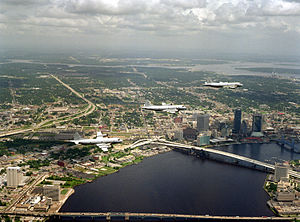 P-3 Orion aircraft from NAS Jacksonville overfly downtown Jacksonville and three of its road bridges, 1994. The Fuller Warren drawbridge in the foreground has since been torn down and replaced by a higher span.
P-3 Orion aircraft from NAS Jacksonville overfly downtown Jacksonville and three of its road bridges, 1994. The Fuller Warren drawbridge in the foreground has since been torn down and replaced by a higher span. Main article: Transportation in Jacksonville, Florida
Main article: Transportation in Jacksonville, FloridaHighways
- Interstate highways
Interstate Highways 10 and 95 intersect in Jacksonville, creating the busiest intersection in the region with 200,000 vehicles each day.[113] Interstate 10 ends at this intersection (the other end being in Santa Monica, California). The eastern terminus of US-90 is in nearby Jacksonville Beach near the Atlantic Ocean. Additionally, several other roads as well a major local expressway, J. Turner Butler Boulevard (SR 202) also connect Jacksonville to the beaches. Interstate 95 has a bypass route, with I-295, which bypasses the city to the west, and SR-9A, bypassing the city to the east. The major interchange at SR 9A and SR 202 (Butler Blvd) was finally completed on December 24, 2008. SR 9B is underway and will connect 9A just east of the I-295 interchange to the Bayard Area.[114]
Mass transit
Public transportation provided by the Jacksonville Transportation Authority (JTA) includes regular and express bus service, downtown trolleys, JTA Connexion (paratransit) and the stadium shuttle. The JTA Skyway is a people mover which travels 2.5 miles (4.0 km) from the King Street parking garage across the St. Johns River and through the central business district, ending at the Convention Center or the Florida State College at Jacksonville downtown campus. Intermediate stops include the government center, central business area and two buildings on the southbank. It was not intended to serve the Jacksonville Sports complex (Stadium, Baseball Park or Arena) and is of limited help for most downtown commuters unless they live on the southside and work in a building close to a skyway station.
Railroads
Jacksonville is the headquarters of two significant freight railroads. CSX Transportation, owns a large building on the downtown riverbank that is a significant part of the skyline. Florida East Coast Railway also calls Jacksonville home.
Amtrak serves Jacksonville by the daily Silver Meteor and Silver Star long distance trains. The current station is situated on Clifford Lane in the northwest section of the city.
Jacksonville was also served by the thrice-weekly Sunset Limited and the daily Silver Palm. Service on the Silver Palm was cut back to Savannah, Georgia in 2002. The Sunset Limited route was truncated at San Antonio, Texas as a result of the track damage in the Gulf Coast area caused by Hurricane Katrina on August 28, 2005. Service was restored as far east as New Orleans by late October 2005, but Amtrak has opted not to fully restore service into Florida. This appears to be more of a managerial and political issue than a physical one.[115] Advocates for the train's restoration have pointed to revenue figures for Amtrak's fiscal year 2004 (the last full year of coast-to-coast Sunset Limited service), noting that the Orlando-New Orleans segment accounted for 41% of the Sunset's revenue.[116]
Airports
Airports in Jacksonville are managed by the Jacksonville Aviation Authority (JAA). The commercial passenger facility is Jacksonville International Airport on the Northside. Smaller planes can fly to Craig Municipal Airport in Arlington and Herlong Airport on the Westside. The JAA also operates Cecil Field, the former NAS airfield at Cecil Commerce Center that is intended for the aerospace and manufacturing companies located there.
Seaports
Public seaports in Jacksonville are managed by the Jacksonville Port Authority, known as JAXPORT. Four modern deepwater (38 ft) seaport facilities, including America's newest cruise port, make Jacksonville a full-service international seaport. In FY2006, JAXPORT handled 8.7 million tons of cargo, including nearly 610,000 vehicles, which ranks Jacksonville 2nd in the nation in automobile handling, behind only the Port Authority of New York and New Jersey.[117]
The 20 other maritime facilities not managed by the Port Authority move about 10 million tons of additional cargo in and out of the St. Johns River. In terms of total tonnage, the Port of Jacksonville ranks 40th nationally; within Florida, it is 3rd behind Tampa and Port Everglades.
In 2003, the JAXPORT Cruise Terminal opened, providing cruise service for 1,500 passengers to Key West, Florida, the Bahamas, and Mexico via Carnival Cruise Lines ship, Celebration, which was retired in April, 2008. For almost five months, no cruises originated from Jacksonville until September 20, 2008, when the cruise ship Fascination departed with 2,079 passengers.[118] In Fiscal year 2006, there were 78 cruise ship sailings with 128,745 passengers.[119] A JaxPort spokesperson said in 2008 that they expect 170,000 passengers to sail each year.[120]
Bridges
There are seven bridges over the St. Johns River at Jacksonville. They include (starting from furthest downstream) the Napoleon Bonaparte Broward Bridge (Dames Point) (which carries Florida State Road 9A traffic), the John E. Mathews Bridge, the Isaiah D. Hart Bridge, the John T. Alsop Jr. Bridge (Main Street), the St. Elmo W. Acosta Bridge, the Fuller Warren Bridge (which carries I-95 traffic) and the Henry Holland Buckman Bridge (which carries I-295 West traffic).
Beginning in 1953, tolls were charged on the Hart, Mathews, Fuller Warren and the Main Street bridges to pay for bridge construction, renovations and many other highway projects. As Jacksonville grew, toll plazas created bottlenecks and caused delays and accidents during rush hours. In 1988, Jacksonville voters chose to eliminate toll collection and replace the revenue with a ½ cent local sales tax increase. In 1989, the toll booths were removed.
The Mayport Ferry connects the north and south ends of State Road A1A between Mayport and Fort George Island, and is the last active ferry in Florida. The state of Florida transferred responsibility for ferry operations to JAXPORT on October 1, 2007.
St. Johns River crossings in the Jacksonville, Florida area Upriver from Downtown Shands Bridge (to be replaced or supplemented) | Buckman Bridge | Timuquana Bridge (never built)
Downtown Jacksonville Fuller Warren Bridge | FEC Strauss Trunnion Bascule Bridge | Acosta Bridge | Main Street Bridge | Hart Bridge | Mathews Bridge | 20th Street Extension (never built)
Downriver from Downtown Dames Point Bridge | State Road 113A (never built) | Mayport Ferry
Sister cities
See also: List of sister cities in FloridaJacksonville has eight sister cities.[121] They are:
 - Bahía Blanca, Argentina (since 1967)
- Bahía Blanca, Argentina (since 1967) - Murmansk, Russia (1975)
- Murmansk, Russia (1975) - Changwon, South Korea (1983)
- Changwon, South Korea (1983) - Nantes, France (1984)
- Nantes, France (1984) - Yingkou, Liaoning, China (1990)
- Yingkou, Liaoning, China (1990) - Port Elizabeth/Nelson Mandela Bay, South Africa (2000)
- Port Elizabeth/Nelson Mandela Bay, South Africa (2000) - Curitiba, Brazil (2009)
- Curitiba, Brazil (2009) - San Juan, Puerto Rico (2009)
- San Juan, Puerto Rico (2009)
- In 2000, The Sister Cities International awarded Jacksonville the Innovation Arts & Culture Award for the city's program with Nantes.
See also
- Montgomery Correctional Center
- National Register of Historic Places listings in Duval County, Florida
- Orange Park, Florida
References
- ^ "Annual Estimates of the Resident Population for Incorporated Places Over 100,000, Ranked by July 1, 2009 Population" (PDF). US Census Bureau. http://www.census.gov/popest/cities/tables/SUB-EST2009-01.csv. Retrieved February 14, 2011.
- ^ "American FactFinder". United States Census Bureau. http://factfinder.census.gov. Retrieved 2008-01-31.
- ^ "US Board on Geographic Names". United States Geological Survey. 2007-10-25. http://geonames.usgs.gov. Retrieved 2008-01-31.
- ^ "Cities with 100,000 or More Population in 2000 ranked by Land Area (square miles) /1, 2000 in Rank Order". U.S. Census Bureau, Administrative and Customer Services Division, Statistical Compendia Branch. March 16, 2004. http://www.census.gov/statab/ccdb/cit1010r.txt. Retrieved October 26, 2010.
- ^ "Find a County". National Association of Counties. http://www.naco.org/Counties/Pages/FindACounty.aspx. Retrieved 2011-06-07.
- ^ "Jacksonville grew 11.7% in 10 years". Jacksonville Business Journal. March 17, 2011. http://www.bizjournals.com/jacksonville/news/2011/03/17/jacksonville-grew-117-in-10-years.html. Retrieved March 30, 2011.
- ^ "Annual Estimates of the Population of Metropolitan and Micropolitan Statistical Areas: April 1, 2000 to July 1, 2008". US Census Bureau. http://www.census.gov/popest/metro/tables/2008/CBSA-EST2008-01.xls. Retrieved October 26, 2010.
- ^ "US Port Ranking by Cargo Volume 2008" American Association of Port Authorities
- ^ Harding, Abel (April 3, 2010). "Golf tourism a boon for Northeast Florida". The Florida Times-Union. http://jacksonville.com/opinion/blog/abel-harding/2010-04-02/golf-tourism-boon-northeast-florida. Retrieved October 26, 2010.
- ^ "Jacksonville". Encyclopaedia Britannica. http://www.britannica.com/EBchecked/topic/298914/Jacksonville. Retrieved October 26, 2010.
- ^ Soergel, Matt (18 October 2009). "The Mocama: New name for an old people". The Florida Times-Union. http://jacksonville.com/news/metro/2009-10-18/story/the_mocama_new_name_for_an_old_people. Retrieved August 3, 2010.
- ^ Milanich, Jerald (1999). The Timucua. Wiley-Blackwell. pp. 48–49. ISBN 0631218645. http://books.google.com/books?id=cndrPgVY4VgC&printsec=frontcover#v=onepage&q&f=false. Retrieved July 12, 2011.
- ^ Davis, Thomas Frederick (1925). History of Jacksonville, Florida and Vicinity, 1513 to 1924. University Press of Florida. p. 24.
- ^ "Exploring Florida.com: Pedro Menendez de Aviles Claims Florida for Spain". Fcit.usf.edu. http://fcit.usf.edu/Florida/lessons/menendz/menendz1.htm. Retrieved August 3, 2010.
- ^ Wood, Wayne (1992). Jacksonville's Architectural Heritage. University Press of Florida. p. 22. ISBN 0813009537.
- ^ Beach, William Wallace (1877). The Indian Miscellany. J. Munsel. p. 125. http://books.google.com/books?id=lqqAAAAAIAAJ&printsec=frontcover&source=gbs_ge_summary_r&cad=0#v=onepage&q&f=false. Retrieved July 12, 2011.
- ^ Wells, Judy (March 2, 2000). "City had humble beginnings on the banks of the St. Johns". The Florida Times-Union. http://jacksonville.com/tu-online/stories/030200/ent_S0302FIR.html. Retrieved 2 July 2011.
- ^ Presidential visits to Florida ... - Google Books. Books.google.com. http://books.google.com/books?printsec=frontcover&id=xjD5x9F1WyoC#PPA1,M1. Retrieved 2010-07-01.
- ^ "Old Confederate Soldiers and Sailors Home 1893 - 1938" in Kirby Smith Camp #1209, Sons of Confederate Veterans at http://www.scv-kirby-smith.org/confederateHOME.htm . Retrieved January 27, 2010.
- ^ "The Jacksonville Silent Film Museum at Norman Studios". http://www.normanstudios.org/. Retrieved 2007-07-19.
- ^ Will Vasana (2000-09-05). "Jacksonville Real Estate website: Better Jacksonville Plan". Bringyouhome.com. http://www.bringyouhome.com/betterjacksonville.html. Retrieved 2010-07-01.
- ^ "Climate Information for Jacksonville, Florida". ClimateZone.com. http://www.climate-zone.com/climate/united-states/florida/jacksonville/. Retrieved 2006-07-23.
- ^ "NOAA/National Climatic Data Center: Table-Mean Number of Days With Minimum Temperature 32 Degrees F or Less". Lwf.ncdc.noaa.gov. 2008-08-20. http://lwf.ncdc.noaa.gov/oa/climate/online/ccd/min32temp.html. Retrieved 2010-07-01.
- ^ See List of snow events in Florida.
- ^ "Weather service, Jacksonville.com users report snow flurries across Northeast Florida". Jacksonville.com. http://jacksonville.com/news/metro/2010-12-26/story/weather-service-jacksonvillecom-users-report-snow-flurries-across. Retrieved 2010-12-26.
- ^ "Jacksonville,Florida's history with tropical systems". HurricaneCity. http://www.hurricanecity.com/city/jacksonville.htm. Retrieved 2006-07-23.
- ^ http://www.news4jax.com/weather/3648478/detail.html
- ^ http://www.srh.noaa.gov/jax/?n=climate Jacksonville (Duval County) climate charts and info
- ^ "Climatography of the United States No. 20 (1971–2000)" (PDF). National Oceanic and Atmospheric Administration. 2004. http://cdo.ncdc.noaa.gov/climatenormals/clim20/fl/084366.pdf. Retrieved 2010-05-18.
- ^ "Climatological Normals of Jacksonville". Hong Kong Observatory. http://www.weather.gov.hk/wxinfo/climat/world/eng/n_america/us/Jacksonville_e.htm. Retrieved 2010-05-18.
- ^ a b "Bank of America Tower". SkyscraperPage.com. http://skyscraperpage.com/cities/?buildingID=3823. Retrieved 7 December 2008.
- ^ a b "Bank of America Tower, Jacksonville Florida". Portfolio — Current Properties. Parameter Realty Partners. http://www.parmco.com/portfolio/boa_tower.html. Retrieved 7 December 2008.
- ^ Emporis GmbH. "Riverplace Tower, Jacksonville". Emporis.com. http://www.emporis.com/en/wm/bu/?id=riverplacetower-jacksonville-fl-usa. Retrieved 2010-07-01.
- ^ "Tallest Buildings in Jacksonville". Emporis.com. 2009-06-15. http://www.emporis.com/en/wm/ci/bu/sk/li/?id=101041&bt=2&ht=2&sro=1. Retrieved 2010-07-01.
- ^ "Citizens Planning Advisory Committee (CPACs)". coj.net. http://www.coj.net/Departments/Housing+and+Neighborhoods/Community+Development/CPACs/default.htm. Retrieved November 3, 2010.
- ^ Wood, Wayne (1992). Jacksonville's Architectural Heritage. University Press of Florida. pp. 3; 7. ISBN 0813009537.
- ^ McEwen, John W. 2007. "The Vernacular Neighborhoods of Jacksonville, Florida: Can GIS Help Determine their Boundaries?" The Florida Geographer, Vol. 38: 54-71.
- ^ Carbone, Marisa; Sarah W. Reiss, John Finotti (2009). Insiders' Guide to Jacksonville, 3rd Edition. Globe Pequot. pp. 181–182. ISBN 0762750324. http://books.google.com/books?id=rlHWoqDYZHkC&printsec=frontcover&source=gbs_ge_summary_r&cad=0#v=onepage&q&f=false. Retrieved May 10, 2011.
- ^ Duval County listings
- ^ "Recreation and Community Services". http://www.coj.net/Departments/Recreation+and+Community+Services/Recreation+and+Community+Programming/default.htm. Retrieved 2008-03-24.
- ^ [1] Waymarking, Five Points Theater, Jacksonville
- ^ [2] Five Points.com, So much history in one small place
- ^ "Ashley Street: The Harlem of the South" Metro Jacksonville, History
- ^ http://www.abettheatre.com/
- ^ "Orange Park Community Theatre". Opct.org. http://www.opct.org/. Retrieved 2010-07-01.
- ^ [3] CitySearch: Jacksonville-Stage Aurora Theatre
- ^ "March 11, 2006-10,000 Participate; Keflezighi Wins Gate River Run". News4Jax.com. 2006-03-11. http://www.news4jax.com/sports/7905330/detail.html. Retrieved 2010-07-01.
- ^ [4] WJXT-TV, March 15, 2009-15K Take To Streets In 15K River Run
- ^ "Superpages Travel reviews". Superpages.com. 2009-06-22. http://www.superpages.com/cities/Jacksonville-FL.html. Retrieved 2010-07-01.
- ^ "The Blues Foundation's List of Festivals". Blues.org. https://www.blues.org/#ref=links_links. Retrieved 2010-11-01.
- ^ a b Reiss, Sarah W. (2009). Insiders' Guide to Jacksonville, 3rd Edition. Globe Pequot. pp. 82–83. ISBN 0762750324. http://books.google.com/books?id=rlHWoqDYZHkC&printsec=frontcover&source=gbs_ge_summary_r&cad=0#v=onepage&q&f=false. Retrieved September 15, 2011.
- ^ a b Chapin, Veronica: [5] Jacksonville Travel
- ^ "INUSA tourguide: Jacksonville, Florida". Inusa.com. http://www.inusa.com/tour/fl/jacksonv/brest.htm. Retrieved 2010-07-01.
- ^ [6] Florida Division of Cultural Affairs, University and College Art Spaces
- ^ Charlie Patton (March 1, 2011). "Jacksonville's Karpeles Manuscript Library Museum has the write stuff". The Florida Times-Union. http://jacksonville.com/entertainment/arts/2011-03-01/story/jacksonvilles-karpeles-manuscript-library-museum-has-write-stuff. Retrieved September 13, 2011.
- ^ Charlie Patton (January 21, 2001). "Get it documented". The Florida Times-Union. http://jacksonville.com/tu-online/stories/012101/dss_5172793.html. Retrieved September 13, 2011.
- ^ Diana Middleton (2008-11-16). "Florida Times-Union: November 16, 2008-Remember when we all used to go to the Mall? by Diana Middleton". Jacksonville.com. http://www.jacksonville.com/tu-online/stories/111608/bus_356443965.shtml. Retrieved 2010-07-01.
- ^ "Jacksonville Jaguars". profootballhof.com. Pro Football Hall of Fame. http://www.profootballhof.com/history/team.aspx?franchise_id=15. Retrieved October 27, 2010.
- ^ Rubenstein, Lorne (2004). Mike Weir: The Road To The Masters. Random House. ISBN 077107574X. http://books.google.com/books?id=pkkkgTvNDMsC&printsec=frontcover&source=gbs_ge_summary_r&cad=0#v=onepage&q&f=false. Retrieved October 27, 2010.
- ^ Pahigian, Josh (2007). The Ultimate Minor League Baseball Road Trip: A Fan's Guide to AAA, AA, A, and Independent League Stadiums. Globe Pequot. p. 201. ISBN 159921024X. http://books.google.com/books?id=1DaQ8oNXuE0C&printsec=frontcover&source=gbs_ge_summary_r&cad=0#v=onepage&q&f=false. Retrieved October 27, 2010.
- ^ "Jacksonville Baseball History". jaxsuns.com. 2010. http://web.minorleaguebaseball.com/team4/page.jsp?ymd=20070103&content_id=150375&vkey=team4_t564&fext=.jsp&sid=t564. Retrieved October 27, 2010.
- ^ "Arena football team to be Sharks". Jacksonville Business Journal. November 18, 2009. http://www.bizjournals.com/jacksonville/stories/2009/11/16/daily23.html. Retrieved October 27, 2010.
- ^ Don Coble (August 12, 2011). "Sharks win ArenaBowl on final play". The Florida Times-Union. http://jacksonville.com/sports/football/sharks/2011-08-12/story/sharks-win-arenabowl-final-play. Retrieved September 2, 2011.
- ^ "Breakaway league launched in the US". code13rugbyleague.com. January 12, 2011. Archived from the original on January 19, 2011. http://www.webcitation.org/5vrIJxNGt. Retrieved January 20, 2011.
- ^ Elliott, Jeff (October 20, 2010). "ABA pro basketball team coming to Jacksonville". The Florida Times-Union. http://jacksonville.com/jeff-elliott/2010-10-20/story/aba-pro-basketball-team-coming-jacksonville. Retrieved November 24, 2010.
- ^ Gurbal, Ashley (November 10, 2010). "Jacksonville Giants will tip off Dec. 4". Jacksonville Business Journal. http://www.bizjournals.com/jacksonville/news/2010/11/10/jacksonville-giants-will-tip-off-dec-4.html. Retrieved November 24, 2010.
- ^ Zima, Mike (December 5, 2010). "Jacksonville Giants romp in overwhelming debut". The Florida Times-Union. http://jacksonville.com/sports/basketball/2010-12-05/story/jacksonville-giants-romp-overwhelming-debut. Retrieved December 6, 2010.
- ^ Ashley Gurbal (April 14, 2011). "New Jax soccer team will play at JU". Jacksonville Business Journal. http://www.bizjournals.com/jacksonville/news/2011/04/14/jax-pro-soccer-team-will-play-at-ju.html. Retrieved June 2, 2011.
- ^ Joe Wilhelm Jr. (August 5, 2011). "Jacksonville lands pro lacrosse". Financial News & Daily Record. http://www.jaxdailyrecord.com/showstory.php?Story_id=534187. Retrieved September 2, 2011.
- ^ Stephen Stamp (August 31, 2011). "Jacksonville Bullies will look to push rest of North American Lacrosse League around". ilindoor.com. http://www.ilindoor.com/2011/08/31/jacksonville-bullies-will-look-to-push-rest-of-north-american-lacrosse-league-around/. Retrieved September 2, 2011.
- ^ Gary, Smits (July 9, 2009). "UNF officially moves to Division I". Jacksonville Business Journal. http://jacksonville.com/sports/college/north_florida_ospreys/2009-07-09/story/unf_officially_moves_to_division_i. Retrieved October 31, 2010.
- ^ "About JU". www.ju.edu. Jacksonville University. 2010. http://www.ju.edu/about.aspx. Retrieved October 31, 2010.
- ^ "Local Television Market Universe Estimates" Nielsen Media Research
- ^ "Arbitron Radio Market Rankings" Arbitron
- ^ "Cox Radio's Market Profile for Jacksonville, Florida". http://coxradio.com/includes/stations/jacksonville.html. Retrieved 2007-07-19.
- ^ "Clear Channel Radio Station List for Jacksonville, Florida". http://www.clearchannel.com/Radio/StationSearch.aspx?RadioSearch=Jacksonville. Retrieved 2007-07-19.
- ^ "Inside wokv.com". http://wokv.com/ads/index.html. Retrieved 2007-07-19.
- ^ http://2010.census.gov/news/releases/operations/cb11-cn95.html
- ^ "The Arab Population: 2000" (pdf). Census 2000 Briefs. United States Census. December 2003. http://www.census.gov/prod/2003pubs/c2kbr-23.pdf. Retrieved April 28, 2011.
- ^ Haya El Nasser (November 20, 2033). "U.S. Census reports on Arab-Americans for first time". USA Today. http://www.usatoday.com/news/nation/2003-11-20-arab-americans_x.htm. Retrieved April 28, 2011.
- ^ American FactFinder, United States Census Bureau. "Jacksonville city, Florida - Selected Social Characteristics in the United States: 2006-2008". Factfinder.census.gov. http://factfinder.census.gov/servlet/ADPTable?_bm=y&-geo_id=16000US1235000&-qr_name=ACS_2008_3YR_G00_DP3YR2&-ds_name=&-_lang=en&-redoLog=false. Retrieved 2010-07-01.
- ^ "MLA Data Center Results of Jacksonville, Florida". Modern Language Association. http://www.mla.org/map_data_results&SRVY_YEAR=2000&geo=&state_id=12&county_id=&mode=&lang_id=&zip=&place_id=35000&cty_id=®ion_id=&division_id=&ll=&a=&ea=&order=r&pc=1. Retrieved 2011-04-11.
- ^ a b c d e "Jacksonville, FL MSA". thearda.com. Association of Religion Data Archives. 2000. http://www.thearda.com/mapsReports/reports/Metro/3600_2000_Theology.asp. Retrieved May 3, 2011.
- ^ "Church Statistics". dosafl.com. 2010. http://www.dosafl.com/navSubLanding.asp?HorizSubNavID=79. Retrieved May 3, 2011.
- ^ Duval County listings at National Register of Historic Places
- ^ "Eastern Rite Churches". dosafl.com. 2010. http://www.dosafl.com/NavLanding.asp?ID=48. Retrieved May 3, 2011.
- ^ "Unitarian Universalist Church of Jacksonville". http://www.uujax.org. Retrieved 2007-07-19.
- ^ http://www.walk2shul.com/lif_articles/jacksonville-fl-jewish-community.php
- ^ "Synagogues". jewishjacksonville.org. 2011. http://jewishjacksonville.org/page.aspx?id=111675. Retrieved May 3, 2011.
- ^ "Islamic Center of Northeast Florida, Inc.". http://icnef.org/. Retrieved 2007-07-19.
- ^ Rincon, Kevin (July 1, 2011). "Alvin Brown takes over as Mayor of Jacksonville". wokv.com. Retrieved on July 1, 2011.
- ^ Gibbons, Timothy J. (May 18, 2011). "Alvin Brown makes history, becoming city's first African-American mayor". The Florida Times-Union. Retrieved on May 18, 2011.
- ^ Dana Treen (April 26, 2011). "Results are in: Duval County no longer state murder capital". The Florida Times-Union. http://jacksonville.com/news/crime/2011-04-26/story/results-are-duval-county-no-longer-state-murder-capital. Retrieved April 28, 2011.
- ^ a b "About dcps: our schools". duvalschools.com. Duval County Public Schools. 2010. http://www.duvalschools.org/static/aboutdcps/new%20residents/aboutdcps.asp#schools. Retrieved April 28, 2011.
- ^ a b Mathews, Jay: America's Best High Schools: The List Newsweek magazine, June 13, 2010. Retrieved April 28, 2011.
- ^ http://www.bishopsnyder.org/ retrieved on May 12, 2007
- ^ Reiss, Sarah W. (2009). Insiders' Guide to Jacksonville, 3rd Edition. Globe Pequot. pp. 189–190. ISBN 0762750324. http://books.google.com/books?id=rlHWoqDYZHkC&printsec=frontcover&source=gbs_ge_summary_r&cad=0#v=onepage&q&f=false. Retrieved May 10, 2011.
- ^ a b "Jacksonville Public Library: A History". http://jaxpubliclibrary.org/lib/history.html. Retrieved 2007-08-19.
- ^ "Jacksonville Public Library: Profile". http://jaxpubliclibrary.org/lib/factsheet.html. Retrieved 2007-08-19.
- ^ "The Better Jacksonville Plan". http://www.betterjax.com/. Retrieved 2007-07-19.
- ^ Reiss, Sarah W. (2009). Insiders' Guide to Jacksonville, 3rd Edition. Globe Pequot. p. 184–187. ISBN 0762750324. http://books.google.com/books?id=rlHWoqDYZHkC&printsec=frontcover&source=gbs_ge_summary_r&cad=0#v=onepage&q&f=false. Retrieved May 10, 2011.
- ^ Reiss, Sarah W. (2009). Insiders' Guide to Jacksonville, 3rd Edition. Globe Pequot. p. 187. ISBN 0762750324. http://books.google.com/books?id=rlHWoqDYZHkC&printsec=frontcover&source=gbs_ge_summary_r&cad=0#v=onepage&q&f=false. Retrieved May 10, 2011.
- ^ Reiss, Sarah W. (2009). Insiders' Guide to Jacksonville, 3rd Edition. Globe Pequot. p. 184. ISBN 0762750324. http://books.google.com/books?id=rlHWoqDYZHkC&printsec=frontcover&source=gbs_ge_summary_r&cad=0#v=onepage&q&f=false. Retrieved May 10, 2011.
- ^ Clark, Hannah (2007-02-16). "Table: Best Cities for Jobs". Forbes.com. http://www.forbes.com/careers/2007/02/15/best-cities-jobs-leadership-careers_cx_hc_0216cityjobs_table.html. Retrieved 2007-12-20.
- ^ Woolsey, Matt (2007-10-31). "In Pictures: America's Fastest-Growing Cities". Forbes.com. http://www.forbes.com/2007/10/31/property-cities-growth-forbeslife-cx_mw_1031realestate_slide_11.html. Retrieved 2007-12-20.
- ^ ""Fortune 500: Florida"". money.cnn.com. http://money.cnn.com/magazines/fortune/fortune500/2011/states/FL.html. Retrieved October 25, 2011.
- ^ "Port of Jacksonville" World Port Source, Port Detail
- ^ "Bnet Business Network: Cities of the United States (2005)-Jacksonville: Economy". Findarticles.com. 2005. http://findarticles.com/p/articles/mi_gx5213/is_2005/ai_n19129622. Retrieved 2010-07-01.
- ^ Gibbons, Timothy J.: [7] Jacksonville.com, January 15, 2009 - Mayport carrier decision made official
- ^ "Bouchard4B website: Things I didn't know about Jaxport". Bouchard4b.pbwiki.com. 2007-09-25. http://bouchard4b.pbwiki.com/About%20Jaxport. Retrieved 2010-07-01.
- ^ [8] Florida Times-Union, May 12, 2009-City visitors left $1 billion here in '08
- ^ [9] Tax Exempt World, Organization Search by City, Jacksonville, Florida
- ^ Hannan, Larry: "Jacksonville’s scrambled I-10/I-95 intersection transforming traffic until 2011" Florida Times-Union, June 7, 2010
- ^ Hannan, Larry: "What’s in a direction? On I-295 in 2010, it depends" Florida Times-Union, January 29, 2009
- ^ "January 10, 2009". Trains4america.wordpress.com. 2009-10-05. http://trains4america.wordpress.com/2009/01/10/more-pressure-for-sunset-limited-restoration/. Retrieved 2010-07-01.
- ^ "Release 06-06: NARP Urges Resumption of New Orleans-Florida Rail Service". National Association of Railroad Passengers. 2006-05-03. http://www.narprail.org/cms/index.php/news_releases/more/nr06_06. Retrieved 2008-12-29.
- ^ "The Florida Legislature Archive: BILL# HB945 RELATING TO the Jacksonville Seaport Authority" (PDF). http://www.leg.state.fl.us/data/session/2002/House/bills/analysis/pdf/2002h0945.tr.pdf. Retrieved 2010-07-01.
- ^ Wells, Judy: [10] Florida Times-Union, September 21, 2008, "Fascination to write home about"
- ^ "The Jacksonville Port Authority". Jaxport. http://www.jaxport.com/. Retrieved 2010-07-01.
- ^ Turner, Kevin: [11] Florida Times-Union, September 19, 2008, "Carnival back with bigger, better ship, the Fascination"
- ^ "Jacksonville Sisters Cities Association". http://www.jsca.org. Retrieved 2007-07-19.
Further reading
- Crackers and Carpetbaggers: Moments in the History of Jacksonville, Florida by John Wilson Cowart
- Heroes all: a history of firefighting in Jacksonville by John Wilson Cowart
- James B. Cooks, Jacksonville: The Consolidation Story, from Civil Rights to the Jaguars, University Press of Florida, 2004.
- Greg Jenkins, Florida's Ghostly Legends And Haunted Folklore: North Florida And St. Augustine, Pineapple Press, 2005.
- Buddy Martin, The Boys from Old Florida: Inside Gator Nation, Sports Publishing, 2006
- Herman Mason, Jr., African-American Life in Jacksonville, Arcadia Publishing, 1997.
- Joanelle Mulrain, Re-Rooting Life's Journeys
- Keeping the Faith: Race, Politics, and Social Development in Jacksonville, Florida, 1940–1970, Greenwood Publishing, 2000.
- John Oehser, Jags to Riches: The Cinderella Season of the Jacksonville Jaguars, St. Martins Press, 1997.
- Daniel Schaefer, From scratch pads and dreams: A ten year history of the University of North Florida, University of North Florida, 1982.
- Jules Wagman, Jacksonville and Florida's First Coast, Windsor Publishing, 1989.
- Dr. Caroyln Williams, Historic Photos of Jacksonville, Turner Publishing Company, 2006.
- 40 years ago this weekend, Jacksonville gave itself a national reputation for violence. The Florida Times-Union.
- Foley, Bill; Wood, Wayne (2001). The great fire of 1901 (1st ed.). Jacksonville, Florida: The Jacksonville Historical Society. ISBN 0-9710261-0-6
External links
- Jacksonville & & the Beaches Convention and Visitors Bureau
- Jacksonville Sisters Cities Association
- City of Jacksonville Official Site
- Duval County Schools
- Jacksonville.com - Florida Times-Union
- Ebook on President Grover Cleveland's visit to the 1888 Sub-Tropical Expo
- Jacksonville Chamber of Commerce
- Jacksonville's Lower St. Johns River Watershed - Florida DEP
- Jacksonville (Florida) at the Open Directory Project
- Jacksonville Public Library
- Jacksonville Demographics
Coordinates: 30°19′10″N 81°39′36″W / 30.319406°N 81.659999°W
Categories:- 1832 establishments in the United States
- Census balances in the United States
- Cities in Duval County, Florida
- County seats in Florida
- Port cities in Florida
- Port settlements in the United States
- Populated places established in 1791
- Populated places on the St. Johns River
- Greater Jacksonville
- Jacksonville, Florida
- Consolidated city–counties in the United States
Wikimedia Foundation. 2010.


